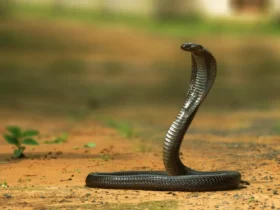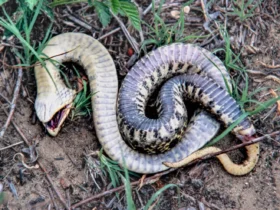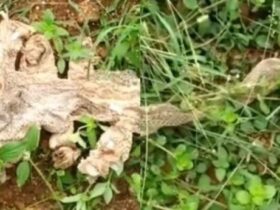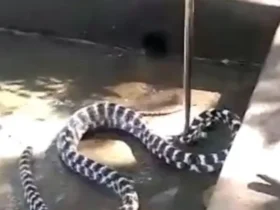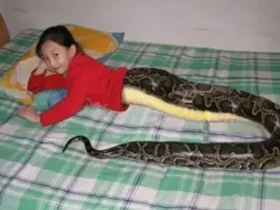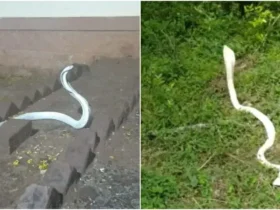At Negara Zoo, visitors can witness a cat living alongside a group of capybaras, also known as Hydrochoerus hydrochaeris, the largest rodents in the world, often referred to as the “diplomats” of the animal kingdom. (According to Straittimes)
It was a sweltering afternoon at Negara Zoo in Malaysia. Tourists paused to watch the capybaras, Hydrochoerus hydrochaeris, nibbling on vegetables and leaves from a 2-meter-high wooden platform.
The capybara enclosure was spacious and situated lower than the walkway, with trees behind and a low stone wall in the front. In the middle, a raised platform provided shelter for the capybaras from the rain and sun. Adjacent to it was a wide, shallow water pool for the capybaras to cool off.
A woman leaned forward and exclaimed, “Oh, look, a cat!” Her family members excitedly took out their phones to capture the moment.
On the right side of the capybara group, a plump, yellow cat sat on the edge, eating tuna from a blue bowl. The cat and the capybaras had been living together for about 2-3 years. This special friendship attracted visitors and helped the zoo recover from the severe impact of Covid-19 on its revenue.


A Special Friendship Revives the Zoo
The zoo staff was not sure when the cat, named Oyen, started living with the capybaras. They only knew that during the closure due to the pandemic, they suddenly noticed Oyen joining the capybaras during meal times.
Capybaras, Hydrochoerus hydrochaeris, are herbivorous and seemingly oblivious to the presence of a carnivorous animal among them.
“When we first saw it, it was very friendly with the capybaras. It ate with them. At that time, we were feeding the capybaras bread, and the cat joined in as well,” said Mohd Taufik Yazidbustami, a senior staff member at the zoo.
Normally, the zoo discourages interaction between domesticated animals and wild animals due to potential dangers. Animal welfare is assessed based on five freedoms: freedom from hunger and thirst, freedom from discomfort, freedom from pain, injury, and disease, freedom to express normal behavior, and freedom from fear and distress.
According to the zoo’s vice president, Rosly Rahmat Ahmat Lana, both the cat and the capybaras are healthy, happy, and show no signs of discomfort. They are closely monitored to ensure their well-being.
The zoo staff has decided to allow this friendship to continue as the cat and the capybaras, Hydrochoerus hydrochaeris, seem to get along well. Oyen is provided with separate food, not just bread.
They believed it to be one of the abandoned pets near the zoo. This area has been a dumping ground for cats even before the pandemic, and it continued during the pandemic as well. The reason is that many people lost their jobs and could no longer afford to take care of their pets.
Negara Zoo, with operating costs of around one million ringgit per month, also faced significant difficulties. The financial crisis hit hard during the initial months of the pandemic when visitor numbers plummeted due to travel restrictions. Resources became scarce.
Mr. Rosly mentioned that the cat was fortunate to not only find food but also a shelter and friendship with the water monitor lizards.
“The cat is very happy. Suddenly, after the zoo reopened, the public noticed it eating together with the water monitor lizards, and that was something special. Oyen has become quite famous,” he said.

The zoo quickly capitalized on this special friendship and used social media to spread the word. Videos featuring Oyen and the water monitor lizards appeared on the official website of the zoo as well as on visitors’ accounts. Numerous clips were shared on social media after the zoo reopened in September 2021, showing Oyen hugging or sleeping with its larger companions.
Diverse opinions
Part of this special friendship is attributed to the natural behavior of the capybara. This semi-aquatic rodent species, scientifically known as Hydrochoerus hydrochaeris, is highly social and can get along with a variety of animals, including dogs and ducks. They are native to the northern and central regions of South America. As for Oyen, many people believe that the yellow cat is friendly and adorable.
Mr. Rosly mentioned that Oyen’s presence has made the capybara enclosure one of the busiest areas in the zoo. They are considering adding Oyen’s information board at the front of the enclosure.
“Most visitors are aware of this. Many people come just to take photos of Oyen with the capybaras. But they are not always successful. If they are lucky to come during feeding time, they can get a photo,” he said.
The capybaras are fed twice a day, at 9:30 AM and 2:30 PM.
Not all visitors are aware of Oyen, but they are excited when they discover a cat living with the capybaras.
“We didn’t know about this, but it’s adorable. We came to see the capybaras, and the presence of the cat adds an interesting surprise. It must be wonderful to live with the capybaras; otherwise, the cat would have run away, right?” shared Seth Deister, a visitor from the United States.
Mr. Rosly mentioned that the situation has improved compared to the restricted travel period when the zoo faced the risk of closure with only emergency funds to care for the animals for three months.


The number of visitors significantly decreased in 2020 and 2021 to 182,000 visitors per year due to social distancing measures. In 2022, when restrictions were eased, the number of visitors increased to 430,000, surpassing the pre-pandemic figure of 350,000. The support from the community and businesses compensated for the shortfall during this period. The government allocated nearly 10 million Ringgit to the Negara Zoo from 2018 to 2022.
Mr. Rosly mentioned that they have now recouped their investment and need to increase revenue to cover expenses and prepare for future emergencies. “We want more visitors because we need to cover exhibition costs, maintain the zoo, and take care of the animals,” he added.
Zoos have not been without controversy. Animal rights activists argue that animals should be free and live in the wild, accusing zoos of exploiting animals under the guise of education. They argue that zoos are no longer necessary as documentaries and TV programs can better teach children to appreciate nature and wildlife.
Former President of the Malaysian Nature Society, Prof. Ahmad Ismail, disagrees. He believes that zoos not only educate and introduce animals, especially endangered species, but also carry out conservation projects.
However, he is unsure about having a cat living among the capybaras, as their interaction could disrupt the usual behavior of this rodent species.
“In a captive environment, it may be cute, but some nature lovers don’t prefer it. They want to see animals behave as they would in the wild,” he said.
He further added that the unusual friendship between the cat and the capybaras could have long-term benefits if it attracts crowds and helps sustain the Negara Zoo.

